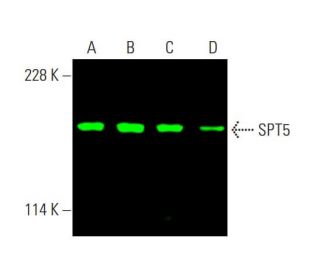
SPT5 Antikörper (D-3): sc-133217
- SPT5 Antikörper D-3 ist ein Maus monoklonales IgG1 κ SPT5 Antikörper, verwendet in 18 wissenschaftlichen Veröffentlichungen, in einer Menge von 200 µg/ml
- gezogen gegen Aminosäuren 61-360 gelegen in der Nähe vom N-terminus von SPT5 aus der Spezies human
- SPT5 Antikörper (D-3) ist empfohlen für die Detektion von SPT5 aus der Spezies mouse, rat und human per WB, IP, IF, IHC(P) und ELISA
- Anti-SPT5 Antikörper (D-3) ist erhältlich als Konjugat mit Agarose für IP; HRP für WB, IHC(P) und ELISA; und entweder mit Phycoerythrin oder FITC für IF, IHC(P) und FCM
- auch erhältlich als Konjugat mit Alexa Fluor® 488, Alexa Fluor® 546, Alexa Fluor® 594 oder Alexa Fluor® 647 für IF, IHC(P) und FCM
- auch erhältlich als Konjugat mit Alexa Fluor® 680 oder Alexa Fluor® 790 für WB (NIR), IF und FCM
- erhältlich als TransCruz Reagenz für ChIP (sc-133217 X, 200 µg/0.1 ml)
- m-IgG Fc BP-HRP, 1 BP-HRP">m-IgG1 BP-HRP und m-IgGκ BP-HRP sind die bevorzugten sekundären Nachweisreagenzien für SPT5 Antikörper (D-3) für WB- und IHC(P)-Anwendungen. Diese Reagenzien werden jetzt in Bündeln mit SPT5 Antikörper (D-3) angeboten(siehe Bestellinformationen unten).
Der SPT5-Antikörper (D-3) ist ein monoklonaler Maus IgG1 κ SPT5-Antikörper, der auch als SUPT5H-Antikörper oder SPT5H-Antikörper bezeichnet wird und das SPT5-Protein von Maus-, Ratte- und menschlicher Herkunft mittels WB, IP, IF, IHC (P) und ELISA detektiert. Der SPT5-Antikörper (D-3) ist sowohl in nicht konjugierter Form als auch in mehreren konjugierten Formen des SPT5-Antikörpers erhältlich, darunter Agarose, HRP, PE, FITC und mehrere Alexa Fluor®-Konjugate. SPT4 (auch als Suppressor of Ty4 und p14 bezeichnet) und SPT5 (auch als DSIF p160 bezeichnet) sind von Hefe bis zu Menschen hochkonservierte Proteine. Nukleäre SPT4 und SPT5 sind sowohl an der DRB (5,6-Dichloro-1-beta-D-Ribofuranosylbenzimidazol)-vermittelten Transkriptionsinhibition als auch an der Aktivierung der Transkriptionselongation durch das HIV-1-Protein Tat beteiligt. SPT4 bindet SPT5, um das DSIF (DRB-Sensitivitäts-induzierendes Faktor)-Komplex zu bilden, der RNA-Polymerase II bindet und direkt die Elongation reguliert. Der SPT5-Protein in mitotischen HeLa-Zellen migriert jedoch im Vergleich zu SPT5, das aus Interphasenzellen isoliert wurde, auf SDS-PAGE langsamer, was auf eine erhöhte Phosphorylierung von SPT5 zurückzuführen ist. Die C-terminale CTR1-Domäne von SPT5 ist das Substrat für die P-TEFb-Phosphorylierung, die für die Funktion von SPT5 als Regulator der Transkriptionselongation entscheidend ist.
Alexa Fluor® ist ein Markenzeichen von Molecular Probes Inc., OR., USA
LI-COR® und Odyssey® sind Markenzeichen von LI-COR Biosciences
SPT5 Antikörper (D-3) Literaturhinweise:
- Struktur und Funktion des menschlichen Transkriptionsdehnungsfaktors DSIF. | Yamaguchi, Y., et al. 1999. J Biol Chem. 274: 8085-92. PMID: 10075709
- Domänen im SPT5-Protein, die seine transkriptionsregulatorischen Eigenschaften modulieren. | Ivanov, D., et al. 2000. Mol Cell Biol. 20: 2970-83. PMID: 10757782
- Die Analyse eines Spleißarray-Experiments klärt die Rolle des Chromatindehnungsfaktors Spt4-5 beim Spleißen auf. | Xiao, Y., et al. 2005. PLoS Comput Biol. 1: e39. PMID: 16172632
- Die C-terminale Domänenphosphatase Ssu72 spielt eine Rolle bei der Transkriptionsverlängerung der RNA-Polymerase II. | Reyes-Reyes, M. and Hampsey, M. 2007. Mol Cell Biol. 27: 926-36. PMID: 17101794
- Der mutmaßliche transkriptionelle Elongationsfaktor hIws1 ist für die Zellproliferation von Säugetieren wesentlich. | Liu, Z., et al. 2007. Biochem Biophys Res Commun. 353: 47-53. PMID: 17184735
- MYC rekrutiert SPT5 an die RNA-Polymerase II, um die prozessive Transkriptionsverlängerung zu fördern. | Baluapuri, A., et al. 2019. Mol Cell. 74: 674-687.e11. PMID: 30928206
- Spt5-Phosphorylierung und die Rtf1-Plus3-Domäne fördern die Rtf1-Funktion durch unterschiedliche Mechanismen. | Chen, JJ., et al. 2020. Mol Cell Biol. 40: PMID: 32366382
- RBM22 reguliert das 5'-Pausieren der RNA-Polymerase II, die Elongationsrate und die Terminierung, indem es den 7SK-P-TEFb-Komplex und SPT5 koordiniert. | Du, X., et al. 2024. Genome Biol. 25: 102. PMID: 38641822
- Identifizierung und Analyse eines funktionellen menschlichen Homologs des SPT4-Gens von Saccharomyces cerevisiae. | Hartzog, GA., et al. 1996. Mol Cell Biol. 16: 2848-56. PMID: 8649394
- Isolierung und Charakterisierung der menschlichen und mausspezifischen Homologen (SUPT4H und Supt4h) des SPT4-Gens der Hefe. | Chiang, PW., et al. 1996. Genomics. 34: 368-75. PMID: 8786137
- DSIF, ein neuartiger Transkriptionsverlängerungsfaktor, der die Prozessivität der RNA-Polymerase II reguliert, besteht aus menschlichen Spt4- und Spt5-Homologen. | Wada, T., et al. 1998. Genes Dev. 12: 343-56. PMID: 9450929
- Nachweis, dass P-TEFb die negative Wirkung von DSIF auf die RNA-Polymerase II-abhängige Transkription in vitro abschwächt. | Wada, T., et al. 1998. EMBO J. 17: 7395-403. PMID: 9857195
Bestellinformation
| Produkt | Katalog # | EINHEIT | Preis | ANZAHL | Favoriten | |
SPT5 Antikörper (D-3) | sc-133217 | 200 µg/ml | $316.00 | |||
SPT5 (D-3): m-IgG Fc BP-HRP Bundle | sc-528773 | 200 µg Ab; 10 µg BP | $354.00 | |||
SPT5 (D-3): m-IgGκ BP-HRP Bundle | sc-521279 | 200 µg Ab, 40 µg BP | $354.00 | |||
SPT5 (D-3): m-IgG1 BP-HRP Bundle | sc-543120 | 200 µg Ab; 20 µg BP | $354.00 | |||
SPT5 Antikörper (D-3) X | sc-133217 X | 200 µg/0.1 ml | $316.00 | |||
SPT5 Antikörper (D-3) AC | sc-133217 AC | 500 µg/ml, 25% agarose | $416.00 | |||
SPT5 Antikörper (D-3) HRP | sc-133217 HRP | 200 µg/ml | $316.00 | |||
SPT5 Antikörper (D-3) FITC | sc-133217 FITC | 200 µg/ml | $330.00 | |||
SPT5 Antikörper (D-3) PE | sc-133217 PE | 200 µg/ml | $343.00 | |||
SPT5 Antikörper (D-3) Alexa Fluor® 488 | sc-133217 AF488 | 200 µg/ml | $357.00 | |||
SPT5 Antikörper (D-3) Alexa Fluor® 546 | sc-133217 AF546 | 200 µg/ml | $357.00 | |||
SPT5 Antikörper (D-3) Alexa Fluor® 594 | sc-133217 AF594 | 200 µg/ml | $357.00 | |||
SPT5 Antikörper (D-3) Alexa Fluor® 647 | sc-133217 AF647 | 200 µg/ml | $357.00 | |||
SPT5 Antikörper (D-3) Alexa Fluor® 680 | sc-133217 AF680 | 200 µg/ml | $357.00 | |||
SPT5 Antikörper (D-3) Alexa Fluor® 790 | sc-133217 AF790 | 200 µg/ml | $357.00 |
